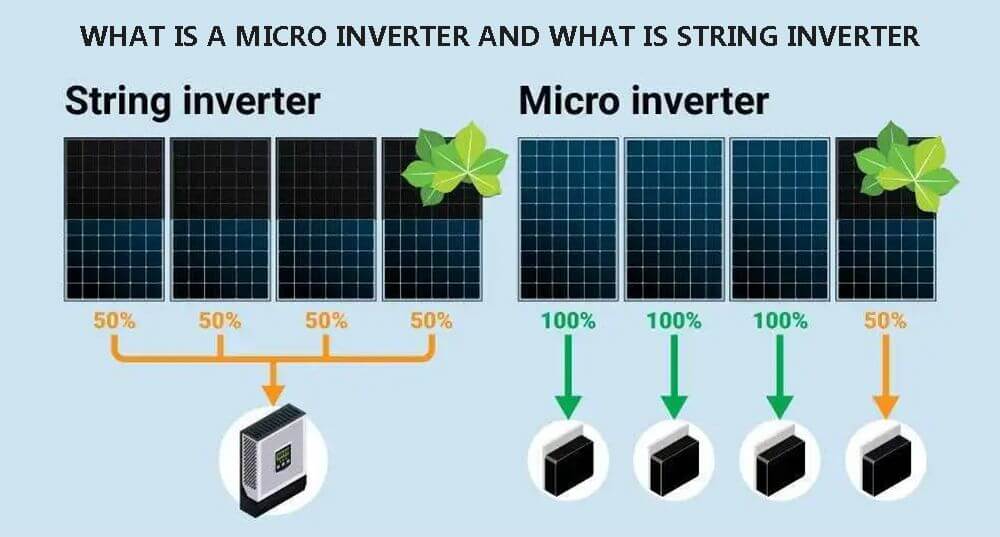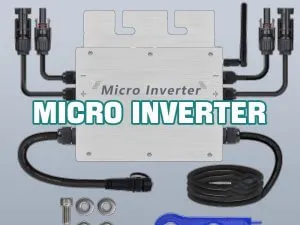Technical comparison of micro inverter vs string inverter

The circuit completes the inverter function by turning on and off the power electronic switch. We have explained micro inverter, string inverter and centralized inverter before.
There are so many types of photovoltaic inverters, which one is better? In this article, I will explain the comparison between micro inverter vs string inverter, which one is more advantageous and more popular among micro inverter vs string inverter.
Features of the micro inverter and string inverter
(1) High efficiency is required.
Due to the high price of solar battery at present, in order to maximize the utilization of solar cells and improve the efficiency of the system, we must try to improve the efficiency of the inverter.
(2) High reliability is required.
At present, the photovoltaic power station system is mainly used in remote areas, and many power stations are unattended and maintained.
This requires the inverter to have a reasonable circuit structure and strict component selection. and the inverter is required to have various protection functions, such as: input DC polarity reverse protection, AC output short circuit protection, overheating, overload protection, etc.
(3)The input voltage is required to have a wider range of adaptation.
Because the terminal voltage of the solar cell varies with the load and the sunlight intensity. Especially when the battery is aging, its terminal voltage varies widely.
For example, for a 12V battery, its terminal voltage may vary between 10V and 16V, this requires the inverter to ensure normal operation within a large DC input voltage range.
What is a micro inverter
The maximum power peak tracking of each photovoltaic module is carried out separately, and then merged into the AC grid after inversion.
The single capacity of this type of inverter is generally below 1KW. Generally, one-to-one, one-to-two, one-to-four connections are used, and each component is equipped with an independent MPPT inverter.
It adopts multiple string access, and has multiple MPPTs, and each MPPT is connected to inverters of single or multiple strings
Application scenarios: Micro-inverters are mainly used in distributed scenarios such as household, small industrial and commercial use due to the relatively low power level of a single inverter and a high safety factor;
Application advantages: String-level monitoring, matching different orientations and inclinations, less string mismatch loss, and low cost per kilowatt-hour.
Application disadvantage: Slightly higher cost than centralized equipment.
What is a string Inverter
Several groups (usually 1-4 groups) of PV strings are individually tracked for the maximum power peak value, and then merged into the AC grid after inversion.
The power of this type of inverter is relatively small, and the single power is generally 100KW.
Application scenarios: The centralized inverter has a high power level of a single inverter and is mainly used in centralized power generation scenarios such as photovoltaic power plants; Small household system or BIPV photovoltaic building integration project.
Application advantages: Component-level monitoring and shutdown, safer DC low voltage, highly adaptable components, and high system efficiency
Application disadvantage: High system cost
Comparison of micro inverter vs string inverter
Under the comparison of micro inverter vs string inverter, micro inverters have higher power generation efficiency, especially in low-power distributed application scenarios, and are safer, more reliable and more flexible than string inverters.
In addition, the technical difficulty of micro-inverters is the highest among photovoltaic inverters, and there are certain barriers.
Therefore, the gross profit margin of the overall micro-inverter is maintained at about 50%, which is higher than that of the string inverter, and the competition is not as fierce as that of the string inverter.
Which is better – micro inverter vs string inverter technology
In 2021, in the photovoltaic inverter market, string inverters will account for 69.6%, centralized inverters will account for 27.7%, and micro inverters will account for about 2.7%.
From a technical point of view in micro inverter vs string inverter, the micro inverter is mainly suitable for household and small-capacity distributed photovoltaic power plants, as well as photovoltaic power plants with high requirements on the safety level of photovoltaic power plants.
For household and small-capacity distributed photovoltaic power plants, due to their small construction capacity and flexible construction methods, string inverters are poorly matched with them.
The selection of micro inverters can flexibly match the construction capacity of photovoltaic power plants, and the matching is significantly improved.
At the same time, such power stations are often built on buildings with high safety requirements.
The small DC input voltage of the micro inverter has no risk of DC arcing, which can meet the relevant safety requirements and improve the safety of the photovoltaic system.
In addition, for the construction of photovoltaic power plants on the roofs of facilities with high safety level requirements, such as gas stations, gas stations, etc., the use of micro inverters can well solve the safety problems of photovoltaic power plants.
Although the string inverter can detect the DC arcing of the PV string and turn it off in time, it cannot fundamentally eliminate the occurrence of the DC arcing.
It only stops the photovoltaic string work in time after the DC arcing occurs.
In order to avoid the continuous occurrence of DC arcing, it is obviously difficult to meet the real explosion-proof requirements for places with high explosion-proof requirements such as gas stations and gas stations.
The lower DC input voltage of the micro inverter fundamentally eliminates the occurrence of DC arcing, and then truly solves the explosion-proof problem of installing photovoltaic systems in flammable and explosive places.
With the continuous development of micro inverter technology, its cost per watt will continue to decrease.
At the same time, the safety requirements of distributed photovoltaic systems are constantly improving, which promotes the increasing use of micro inverters.
Conclusion
It seems that the micro inverter is very promising and advantageous in the comparison of various aspects of micro inverter vs string inverter.
It is believed that in the near future, micro inverter will be widely used in various photovoltaic systems like traditional centralized and string inverters.
If you want to know more about inverters, please refer to pv inverter companies and micro inverter companies, and the following related articles.


























